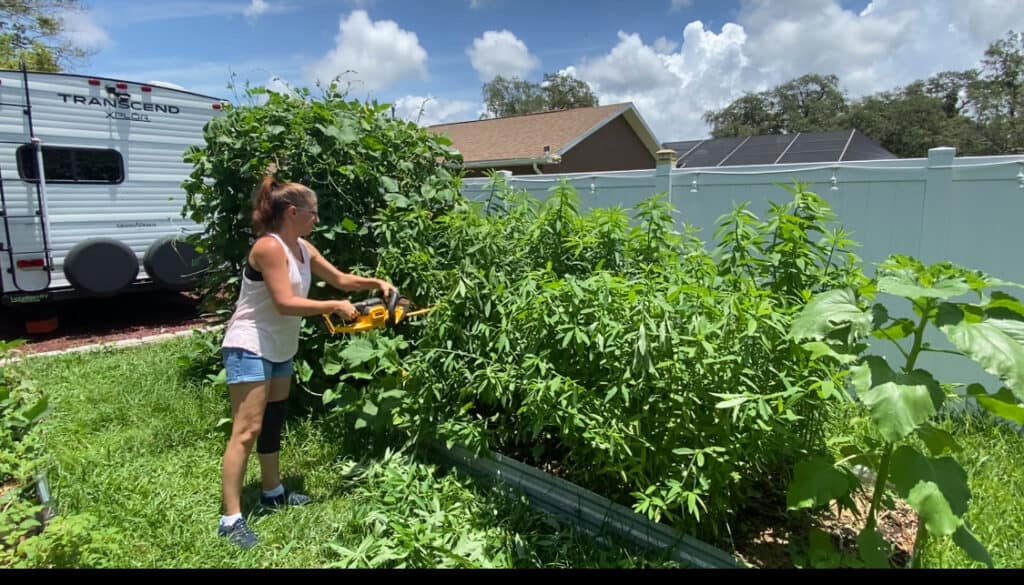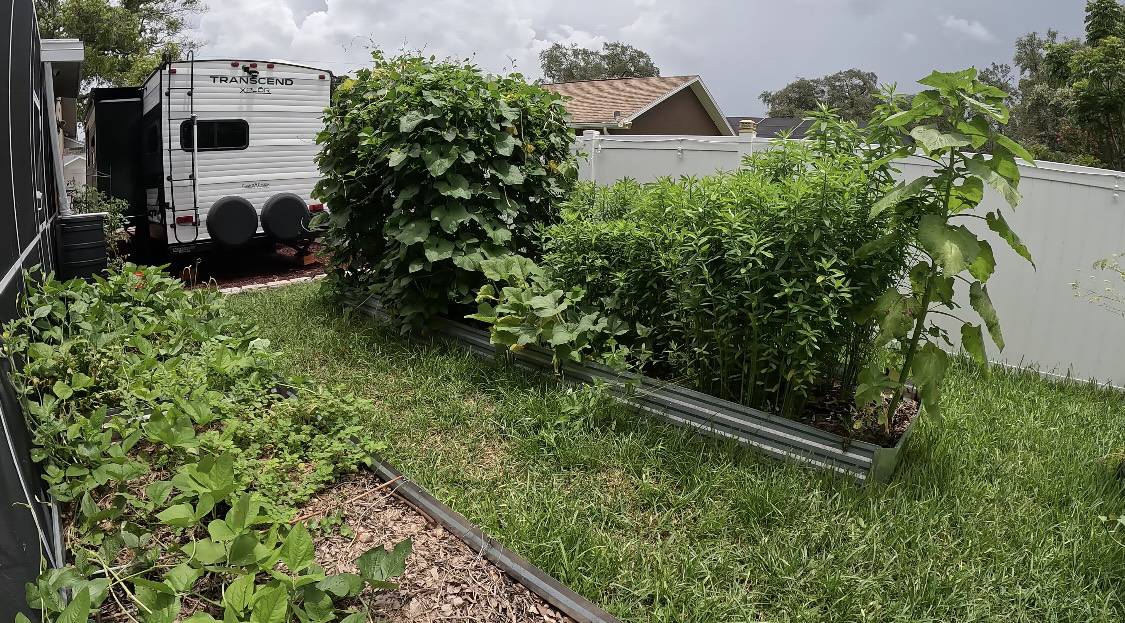Last Updated on March 6, 2025 by Homegrown Florida
March is here, and that means it’s go time for Florida gardeners! If you haven’t started your spring garden yet, don’t worry—there are still plenty of vegetables you can plant right now. The weather this year is warming up much faster than usual, so our planting strategy needs to shift slightly. I typically ease into warm-season crops this time of year, but with these sudden temperature jumps, we’re moving straight into hot-weather planting. Check out my regular planting schedule to plant in Florida.
This post may contain affiliate links. Read full disclosure here.
Table of Contents
This guide is specifically for those of us gardening in Florida but is helpful for Zones 8A to 11, as well. If you’re in Zone 8, your last frost date is either happening now or has just passed. A great way to check if it’s safe to plant warm-weather crops is to look at your 10-day forecast. If nighttime temperatures are staying above 40°F, you’re good to go. For those of us farther south, we don’t have to worry about frost anymore, but we do need to start preparing for the heat.
Greens: Making the Seasonal Shift
If you’re in Northern Florida (Zone 8A/8B), you can still squeeze in a quick crop of heat-tolerant lettuce varieties and leafy greens like Swiss chard before the real heat sets in. I wouldn’t recommend planting large, slow-growing greens like collards at this point because they won’t have enough time to mature before summer.

For Central and South Florida (Zones 9 and 10), it’s time to move away from lettuce and switch to tropical greens. Here are some heat-tolerant options that will grow well through summer:
- Swiss chard – Can handle heat but will need shade to prevent bitterness.
- Malabar spinach (red or green) – Loves the heat and thrives in humid conditions.
- Longevity spinach & Okinawa spinach – Super easy to grow and works great in containers.
- Sisso spinach – One of my favorites! It grows year-round, tastes similar to regular spinach, and works well as a ground cover under fruit trees.
If you’re set on growing lettuce, your best bet is growing indoors with hydroponics. I use my AeroGarden indoor system to grow fresh lettuce inside when it gets too hot outside. AeroGarden has been a little hard to find lately, but any hydroponic system will work.
Fruiting Crops: What to Plant in Florida
Tomatoes, peppers, eggplants, cucumbers, and squash are the main warm-season crops that Florida gardeners plant in March. However, because the heat is coming in so fast, the best approach depends on your exact location:
- Zone 8: If you’re in North Florida, you can still start cucumbers from seed, but for tomatoes and eggplants, buy transplants instead of starting from seed.
- Zone 9 and warmer: You should have planted tomatoes and eggplants already. If you didn’t, grab mature transplants ASAP—seeds won’t have enough time to grow before the extreme summer heat sets in.
Can You Still Grow Peppers?
Yes! Peppers can still be planted across all zones in Florida, but start with transplants at this point. Hot peppers tend to do better through summer than sweet peppers, so keep that in mind if you want an extended harvest.
Heat-Tolerant Squash Varieties
While traditional zucchini and summer squash struggle in Florida’s summer heat, tropical squashes thrive. If you still want to plant squash, go for:

- Tromboncino squash
- Tatume (Calabacita) squash
- Seminole pumpkins
- Tahiti melon squash
These varieties can handle our high humidity, intense sun, and pest pressure much better than traditional summer squash. If you’re in Zone 10 or 11, you might be cutting it close, but if you find a partially shaded spot, you can still plant these.
Beans, Corn, and Melons: Non-Traditional Warm Crops
These crops do great in Florida’s warming spring temperatures, but you need to plant them now before summer becomes too intense:
Beans
- Bush and pole beans can still be planted from seed.
- They grow quickly but will need some afternoon shade to prevent heat stress.
- Dry beans (black beans, kidney beans, etc.) can also be started.
Corn
Normally, March is prime time to start corn, but this year’s extreme heat has me a little hesitant. Corn can handle hot weather, but it requires a ton of water and nutrients to perform well. If you’re planting corn now, be prepared to fertilize regularly and watch for pest issues.
Melons
Melons love the heat! Now is the perfect time to plant:
- Watermelons
- Cantaloupes
- Honeydew melons
However, melons come with big challenges in Florida—pests and diseases. The best way to keep your plants healthy is to:

- Grow melons up a trellis to improve airflow.
- Be proactive with treatments—I spray my plants weekly with BT for pests and hydrogen peroxide for powdery mildew. If you wait until you see a problem, it’s usually too late.
Hot Weather Crops to Start Now
Once we get into April and May, many traditional crops stop thriving. That’s why March is the best time to start heat-loving crops, so they have time to establish before peak summer. Here’s what you should plant now:
- Okra – Loves the heat, low-maintenance.
- Cowpeas (black-eyed peas, purple hull peas, etc.) – Thrive in extreme heat and improve soil health.
- Sweet potatoes – Start your slips now if you haven’t already.
- Jicama – Takes a while to grow but does great to plant in Florida summers.
- Peanuts – Easy and fun to grow.
Starting Sweet Potato Slips

If you haven’t started your sweet potato slips yet, get on it now! Slips take about 6 weeks to grow from a potato, so starting now will ensure you’re ready to plant in late April or May. If you have existing sweet potato vines, you can cut and re-root them instead of starting from scratch.
Cover Cropping for Summer
If you don’t want to garden through summer, plant a cover crop instead of leaving your beds empty. One of the best cover crops to plant in Florida is sun hemp.

- Adds tons of nitrogen to the soil (great for prepping your garden for fall).
- Loves Florida heat—it thrives in hot, humid conditions.
- Prevents weeds from taking over your beds.
To use sun hemp, seed it heavily, let it grow waist-high, then chop it down and let it decompose as mulch. This method builds organic matter in your soil while keeping your garden active.
Final Thoughts
This year’s weather is shifting faster than usual, so Florida gardeners need to adapt. If you want a productive summer garden, March is the time to get your warm-weather crops started. Whether you’re growing tomatoes, squash, beans, or tropical greens, planting now will give your plants time to establish before the heat peaks. Happy gardening!



